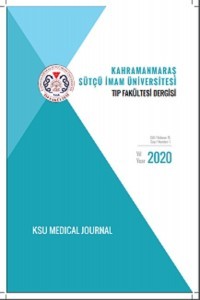Kemoterapiye Bağlı Alopesi Sıklığı ve Hastaların Baş etme Yöntemleri
chemotherapy, cancer, gender
Determination of the Factors Affecting the Frequency and of Chemotherapy- Induced Alopecia and Methods of Coping with Alopecia
chemotherapy, alopecia, canser,
___
- 1. Bahçetepe N, Kutlubay Z, Engin B, Tüzün Y. Cutaneous Effects Of Chemotherapeutic Agen. Dermatoz .2019 ;4: 69-76.
- 2. Türkiye Kanser İstatistikleri. (2014). Electronic Resources [Online]. Available From: Https://Hsgm.Saglik.Gov.Tr/Tr/Kanser-İstatistikleri/Yillar/495-2014-Y%C4%B1l%C4%B1-T%C3%Bcrkiye-Kanser-İstatistikleri.Html. Sayfa 44- Satır 1-10 (Erişim 15 Ocak 2020)
- 3. Baykara O. Current Modalıtıes In Treatment Of Cancer. Balıkesır Health Scıences Journal.2016; 5:154-165.
- 4. Bichsel KJ, Gogia N, Malouff T, Et Al. Role For The Epidermal Growth Factor Receptor İn Chemotherapy-İnduced Alopecia. Plos One.2013; 8: 7e69368.
- 5. Choi EK, Kim IR, Chang O, Kang D, Nam SJ, Lee JE, Lee SE. Impact Of Chemotherapy-İnduced Alopecia Distress On Body İmage, Psychosocial Well-Being, And Depression İn Breast Cancer Patients. Psycho-Oncology. 2014;23: 1103–1110.
- 6. Gupta S, Khatoon R, Hair Loss-An Analys And Updated Treatment. Journal Of Dental And Medical Sciences.2015; 14:77-812.
- 7. Aygın D, Eti Aslan F. A Study Of Sexual Dysfunctıon In Women Wıth Breast Cancer. The Journal Of Breast Health 2008; 4:105-114.
- 8. Batchelor D. Hair And Cancer Chemotherapy: Consequences And Nursing Care A Literature Study. European Journal Of Cancer Care 2001;10: 147-163. 8.
- 9. Breed W, Van Den Hurk C, Peerbooms M. Presentation, İmpact And Prevention Of Chemotherapy-İnduced Hair Loss: Scalp Cooling Potentials And Limitations. Expert Rev Dermatol.2011; 6:109.
- 10. Karabulutlu Ö. Kemoterapi Alan Hastalarda Semptom Yönetimi ve Yaşam Kalitesinin Sürdürülmesi. İstanbul Universty Florence Nightingale Journal Of Nursing 2009;17: 218-225.
- 11. Komen MM, Smorenburg CH, Van Den Hurk CJ, Nortier JW. Factors İnfluencing The Effectiveness Of Scalp Cooling İn The Prevention Of Chemotherapy-İnduced Alopecia. Oncologist.2013; 18:885.
- 12. Chon SY, Champion RW. Geddes ER. Rashid RM. Chemotherapy-İnduced Alopecia. J Am Acad Dermatol.2012; 67: E37. 13. Can G. Side Effects Of Antineoplastic Drugs And Nursing Approaches. Journal Of Education And Research In Nursing.2005; 2:8-15.
- 14. Ateş AS, Olgun N. Perceptions And Attitudes Of Nurses Towards Chemotherapy Induced Alopeciajournal Of Academic Reserach İn Nursing.2015; 1:15.
- 15. Carelle N, Piotto E, Bellanger A, Germanaud PDJ. Thuillier A. Khayat MD. Changing Patient Perceptions Of The Side Effects Of Cancer Chemotherapy. Cancer .2005;95 155-163.
- 16. Mcgarvey EL , Baum LD , Pinkerton RC , Rogers LM: Psychological Sequelae And Alopeciaamaong Women 2001;9:283-9. 17. Dueland S. Sauer T. Lund-Johansen F, Et Al. Epidermal Growth Factor Receptor İnhibition İnduces Trichomegaly. Acta Oncol.2003; 42:345.
- 18. Fonia A, Cota C. Setterfield JF, Et Al. Permanent Alopecia İn Patients With Breast Cancer After Taxane Chemotherapy And Adjuvant Hormonal Therapy: Clinicopathologic Findings İn A Cohort Of 10 Patients. J Am Acad Dermatol.2017; 76:948.
- 19. Hunt N, Mchale S. The Psychological İmpact Of Alopecia. BMJ (Clinical Research Ed.), 2005; 331(7522), 951–953.
- 20. Shin H, Jo SJ, Kim DH, Et Al. Efficacy Of İnterventions For Prevention Of Chemotherapy-İnduced Alopecia: A Systematic Review And Meta-Analysis. Int J Cancer.2015; 136: E 442.
- 21. Saraswat N, Chopra A. Sood A K.Amboj P, Kumar S. Descriptive Study To Analyze Chemotherapy-Induced Hair Loss And İts Psychosocial Impact İn Adults: Our Experience From A Tertiary Care Hospital. İndian Dermatol Online J.2015; 10: 426-430.
- 22. Hindistan S, Çilingir D, Nural N, Akkaş Gürsoy A. Applıcatıons Of Patıents Wıth Hematologıc Cancers For Experıenced Symptoms Due To Chemotherapy. Gümüşhane University Health Scıences Journal 2012; 153-164.
- 23. Botchkarev VA, Komarova EA, Siebenhaar F, Et Al. P53 İs Essential For Chemotherapy-İnduced Hair Loss. Cancer Res.2000; 60:5002.
- 24. Glaser DA,Hossain P, Perkins W, Et Al. Long-Term Safety And Efficacy Of Bimatoprost Solution 0·03% Application To The Eyelid Margin For The Treatment Of İdiopathic And Chemotherapy-İnduced Eyelash Hypotrichosis: A Randomized Controlled Trial. Br J Dermatol.2015; 172:1384.
- ISSN: 1303-6610
- Yayın Aralığı: Yılda 3 Sayı
- Başlangıç: 2004
- Yayıncı: Kahramanmaraş Sütçü İmam Üniversitesi
Sule AYDIN, Çiğdem TOPRAK, Çiğdem ÇENGELLİ ÜNEL, Bilgin KAYGISIZ, Kevser EROL
Graf Tip 2a Kalçalarda Sonografik Bozulma ile İlişkili Faktörlerin İncelenmesi
Duran TOPAK, Kamil DOĞAN, Mustafa Abdullah ÖZDEMİR, Burak KUŞÇU, Ahmet TEMİZ, Ökkeş BİLAL
Murat ŞAHAN, Mehmet Erhan AYDIN, Serkan YARIMOĞLU, Ömer KORAŞ, Salih POLAT, Fatih GOKALP, Serdar ÇELİK
Kardiyovasküler Sistem Hastalıklarında Ağız ve Diş Sağlığının Önemi
Servikal Lazer Diskektomide Başlangıç Görsel Analog Skala Skorunun Sonuçlara Etkisi
Koroner Arter By-pass Greft Ameliyatı Olan Hastalarda İz Bırakan Deneyimlerinden Bugüne Yolculuk
Gülden KÜÇÜKAKÇA ÇELİK, Seçil TAYLAN
Acil Servise Başvuran Hipertansif Hastalarda Serum Ürik Asit Düzeyleri
Canan AKMAN, Serkan BAKİRDOGEN
Ahmet Burak AĞAOĞLU, Kadir GİŞİ, Murat İSPİROĞLU, Abdulkadir Yasir BAHAR, Fatma İNANÇ TOLUN, Bülent KANTARÇEKEN
Servikal Sagital Eğimin Postüral Salınım ve Denge Üzerine Etkisi
Hilal AKAY, Adnan DEMİREL, Ejder BERK, Vedat NACİTARHAN, Murat BAYKARA
